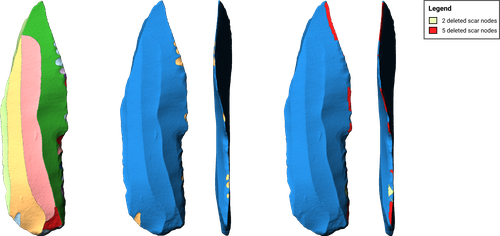
LIN Sam
- School of Earth, Atmospheric and Life Sciences, University of Wollongong, Wollongong, Australia
- Ancient Palaeolithic, Asia, Computational archaeology, Europe, Landscape archaeology, Lithic technology, Middle Palaeolithic, Palaeoanthropology, Raw materials, Spatial analysis, Taphonomy, Theoretical archaeology, Upper Palaeolithic
- recommender
Recommendation: 1
Reviews: 0
Recommendation: 1

From Scar to Scar: Reconstructing Operational Sequences of Lithic Artifacts using Scar-Ridge-Pattern-based Graph Models
A promising step toward objective quantification of flake scar sequences in stone artifact analysis
Recommended by Sam Lin based on reviews by 3 anonymous reviewersDetermining the relative order of flake scar negatives on stone artefacts is critical for reconstructing past lithic reduction sequence and technological practices. This task, which forms a key component of the chaîne opératoire approach of lithic analysis, relies on analysts interpreting scar patterns based on various artefact morphological properties. However, its interpretive nature makes the results highly dependnt on observer experience and susceptible to inter-observer error (see Kot et al. 2025). In this innovative study, Linsel and colleagues (2025) introduce a workflow that automates the determination of relative scar ordering from 3D artefact models. Using a set of parameters that approximate flake scar properties relevant to scar order differentiation, their approach summarises scar ordering in the form of a graph model. The authors test the workflow on two datasets--one created by the authors and another sourced from published artefact models--yielding promising results for high-resolution 3D models but variable accuracy overall. The authors explore possible factors influencing these variations and proposed future refinements, including a need for more ground-truthing datasets with minimal interpretive biases.
This method-focused paper has significant implications for Palaeolithic archaeology. It marks an important step toward the objective quantification of flake scar order, a key aspect in understanding past stone tool-making sequences. Moreover, it highlights the great potential of 3D technology and computational approaches in automating traditionally time-consuming analyses while reducing subjective bias in our analytical results.
References
Florian Linsel, Jan Philipp Bullenkamp, Hubert Mara (2025) From Scar to Scar: Reconstructing Operational Sequences of Lithic Artifacts using Scar-Ridge-Pattern-based Graph Models. Zenodo, ver.2.1 peer-reviewed and recommended by PCI Archaeology https://doi.org/10.5281/zenodo.14875156
Kot, Małgorzata, Jerzy Tyszkiewicz, Michał Leloch, Natalia Gryczewska, and Sebastian Miller (2025) Reliability and validity in determining the relative chronology between neighbouring scars on flint artefacts. Journal of Archaeological Science 175 (2025): 106156. https://doi.org/10.1016/j.jas.2025.106156